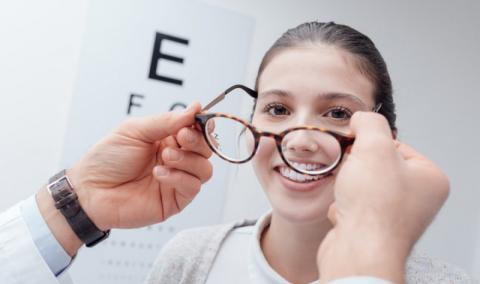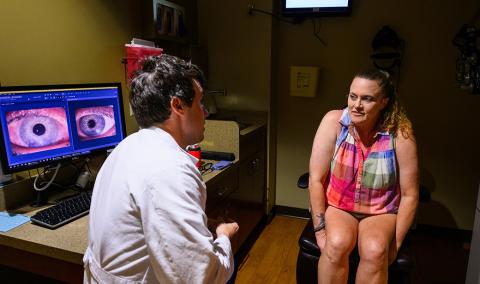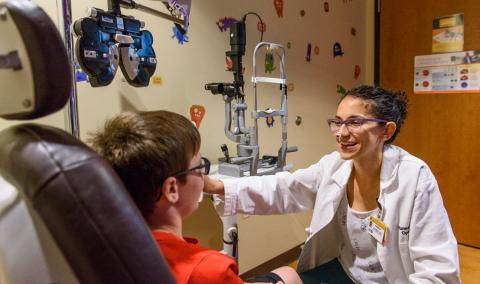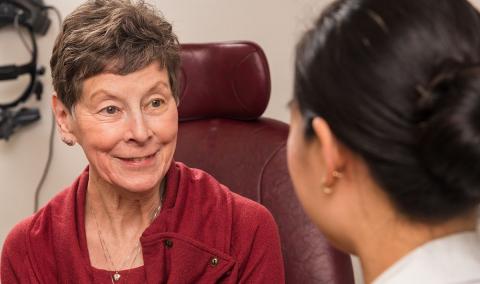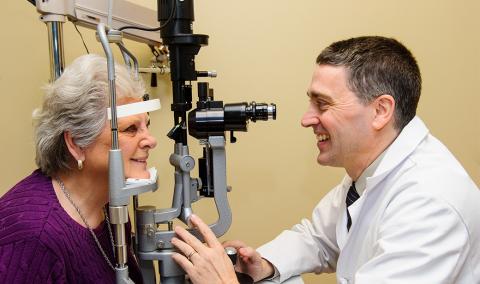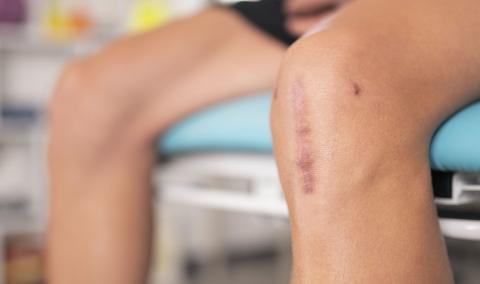Many eye and vision problems don’t have symptoms, but specialized testing can help discover eye health problems early to help prevent vision loss. It’s important to work with experienced eye care specialists you can trust.
The Mason Eye Clinic at University Hospital offers the most advanced diagnosis for eye and vision problems in central Missouri. Our eye care doctors (ophthalmologists) use sophisticated equipment and testing techniques to detect illness at the earliest stages. As an academic health center, we offer medical capabilities you cannot find anywhere else nearby — including comprehensive eye care for kids.
When you choose MU Health Care, you can depend on an experienced team and a full range of eye care services. Whether you need a prescription for eyeglasses or a complicated surgery, we can take care of all your eye care needs in one location.
Comprehensive diagnostic eye exams
Our ophthalmologists use a variety of noninvasive tests to evaluate your eyes and diagnose health conditions. We use the most technologically advanced equipment to examine your eyes and provide your doctor with detailed information for diagnosis and treatment planning.
We offer a full spectrum of eye testing services — everything from color vision, external photography and depth perception testing to highly precise measurements to customize lens implants.
Biomicroscopic photography
Biomicroscopic imaging exams provide 3-D pictures of your cornea (the clear, outer covering of your eye), iris (colored part of your eye), lens, and the fluid in the middle of your eye (vitreous gel). Your doctor can use special lenses to examine deeper structures in your eye. Biomicroscopic imaging helps diagnose many problems, including diseases, infections or foreign objects in your eye.
Corneal topography
Also called videokeratography, this exam maps the curve of your cornea. It can show problems on the surface of your eyes, such as swelling or scarring, or diagnose astigmatism. Your doctor may use this test for a contact lens fitting or to evaluate your eyes before surgery.
Electroretinogram (ERG)
ERG testing detects abnormal function of your retina by examining the light-sensitive cells in your eye (rods and cones) and measuring your nerves’ electrical activity. Your doctor may use this test to evaluate retinal diseases, such as macular degeneration or cataracts.
Fundus photography
These exams — including IVFA (intravenous fluorescein angiography) and ICG (indocyanine green) angiography — take pictures of your retina (the light-detecting part of your eye) and provide a clear view of your optic nerve, blood vessels and other structures in your eye. The tests allow your doctor to examine blood flow in your retina and diagnose diabetic retinopathy, retinal detachment and macular degeneration.
Intraocular pressure (IOP)
Also called tonometry, this exam measures the pressure inside your eye. Your doctor uses this test to check for glaucoma.
Keratometry
Keratometry measures the curvature of your cornea using a special instrument (keratometer). The exam helps your doctor determine the right curve and size of your contact lenses.
Ocular axial length (OAL) measurement
This test measures the shape and size of your eye. Your doctor may use this test to calculate the strength of an intraocular lens implant that’s required for cataract or refractive surgeries.
Optical coherence tomography (OCT)
OCT takes 3-D pictures of your retina. The test allows your doctor to map and measure the thickness of each layer of your retina. The measurements help diagnose and provide treatment guidance for glaucoma and retinal diseases, including age-related macular degeneration and diabetic eye disease.
Refraction
A refraction test helps your doctor create your eyeglasses prescription. The test uses a special tool (phoropter) that has lenses of different strengths to analyze your eyesight. It can diagnose conditions such as nearsightedness, farsightedness and astigmatism.
Ultrasound
Ultrasound exams use sound waves to examine the inside of your eye. These tests are used to diagnose and treat tumors, cataracts and bleeding in your eye. Tests include:
- A-scans that measure your eye and can help your doctor determine the right lens implant for cataract surgery.
- B-scans that show the space behind your eye, which can be difficult to see when you have cataracts or other conditions. A B-scan can help your doctor diagnose tumors, retinal detachment and other conditions.
Visual Field Test
A visual field test measures your peripheral (side) vision. This test helps determine if a health condition, such as a stroke or glaucoma, has damaged your vision.
Visual evoked potential (VEP)
VEP measures electrical activity in your vision system to assess how your eyes communicate with your brain. It can help your doctor detect neurological conditions.




